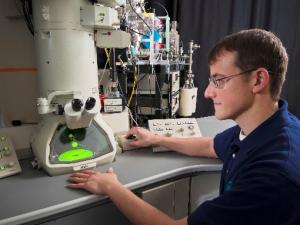Event Actions
We are very excited to welcome Prof. Khalid Hattar from the University of Tennessee Knoxville (UTK), he will be delivering a seminar on Thurs. Nov 13th. Prof. Hattar is renowned for his work pioneering coupled extreme environments in a transmission electron microscope, including coupled dual beam ion irradiations inside a liquid cell Transmission electron microscope (TEM), and probing gas-cell reactions with an externally coupled optical laser upstream in a TEM. He will share some of the latest developments in his lab, and give insights into the future directions of in-situ TEM.
All UVA students, faculty, and staff are welcome. Light refreshments will be provided.
Abstract
To design systems for many current and future energy sources, a detailed understanding of the essential materials in these systems and the associated evolution in these complex environments of interest is needed. One example is the current generation of nuclear reactors which is a complex combination of radiation (displacement and transmutation products), thermal, mechanical (creep and fatigue), and corrosive stressors making it difficult to predict materials performance. The materials design and selection become even more difficult under the higher temperature, displacement damage, and corrosive conditions desired for most next generation nuclear systems. To inform, refine, and validate the ever-advancing predictive physics-based models, tools must be developed to explore the desired environments at the necessary resolution. This presentation will highlight electron microscopy, both at Transmission Electron Microscopy (TEM) and Scanning Electron Microscopy (SEM) developed for such studies at Sandia National Laboratories over the past 16 years as well as the current development for the Tennessee Ion Beam Materials Lab (TIBML) that started in January 2023 of a new Scanning TEM (STEM) for coupled extreme environments. The environments that must be investigated include displacement damage, swelling, hydrogen embrittlement, high temperature creep, irradiation induced creep, high cycle fatigue, corrosion, and often various combinations thereof. Although complex with many engineering challenges, the development of such tools to gain fundamental understanding of materials degradation with nanometer resolution is physically possible and fun! Examples highlighting these capabilities will be presented including results relevant to fusion energy systems, tritium producing burnable absorber rods, spent nuclear fuel, nanomaterial-based radiation detectors, pipeline grade steels, and even solar wind.
Speaker Profile
Khalid Hattar is an Associate Professor in the Nuclear Engineering Department and Director of Tennessee Ion Beam Materials Lab at the University of Tennessee, Knoxville. Previously he served as a technical staff member for 14 years in the Department of Radiation-Solids Interaction and Center for Integrated Nanotechnologies at Sandia National Laboratories. He received a B.S. in Chemical Engineering from University of California, Santa Barbara in 2003, and a Ph.D. in Materials Science and Engineering from University of Illinois, Urbana-Champaign in 2009. He specializes in determining the property-microstructure relationships for a variety of structural, electrical, and optical materials through in situ TEM in various extreme environments, as well as tailoring local properties of materials through ion beam modification.
